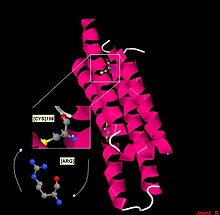Familial dysbetalipoproteinemia
| Familial dysbetalipoproteinemia | |
|---|---|
| Other names | Remnant hyperlipidemia,Remnant hyperlipoproteinaemia,Broad beta disease[1]andRemnant removal disease[1] |
 | |
| Familial dysbetalipoproteinemia is caused by this point mutation in ApoE | |
| Specialty | Medical genetics,endocrinology |
Familial dysbetalipoproteinemiaortype III hyperlipoproteinemiais a condition characterized by increased total cholesterol andtriglyceridelevels, and decreased HDL levels.[2]
Signs and symptoms
[edit]Signs of familial dysbetaproteinemia includexanthoma striatum palmare(orange or yellow discoloration of the palms) andtuberoeruptive xanthomasover the elbows and knees. The disease leads to prematureatherosclerosisand therefore a possible early onset ofcoronary artery diseaseandperipheral vascular diseaseleading to a heart attack, i.e.myocardial infarction,chest pain on exercise, i.e.angina pectorisor stroke in young adults or middle aged patients.[3]
Causes
[edit]This condition is more likely when a mutation inapolipoprotein E(ApoE) is present. ApoE serves as aligandfor theliverreceptor forchylomicrons,IDLandVLDL,also known asvery-low-density-lipoprotein receptor.Individuals with two copies of the ApoE2 gene have substantially elevated risk of this condition.[4][5]This defect prevents the normal metabolism of chylomicrons, IDL and VLDL, otherwise known as remnants, and therefore leads to accumulation of cholesterol within scavenger cells (macrophages) to enhance development and acceleration of atherosclerosis.
Diagnosis
[edit]This section is empty.You can help byadding to it.(November 2017) |
Treatment
[edit]First line of management is fibrates.[citation needed]
See also
[edit]References
[edit]- ^abRapini, Ronald P.; Bolognia, Jean L.; Jorizzo, Joseph L. (2007).Dermatology: 2-Volume Set.St. Louis: Mosby.ISBN978-1-4160-2999-1.
- ^James, William D.; Berger, Timothy G.; et al. (2006).Andrews' Diseases of the Skin: clinical Dermatology.Saunders Elsevier. p. 534.ISBN978-0-7216-2921-6.
- ^Genest J, Libby P. Lipoprotein disorders and cardiovascular disease. In: Bonow RO, Mann DL, Zipes DP, Libby P, eds. Braunwald's Heart Disease: A Textbook of Cardiovascular Medicine. 9th ed. Philadelphia, PA:Saunders Elsevier; 2011:chap 47.
- ^"APOE gene".
- ^"Apolipoprotein E and familial dysbetalipoproteinemia: clinical, biochemical, and genetic aspects".
